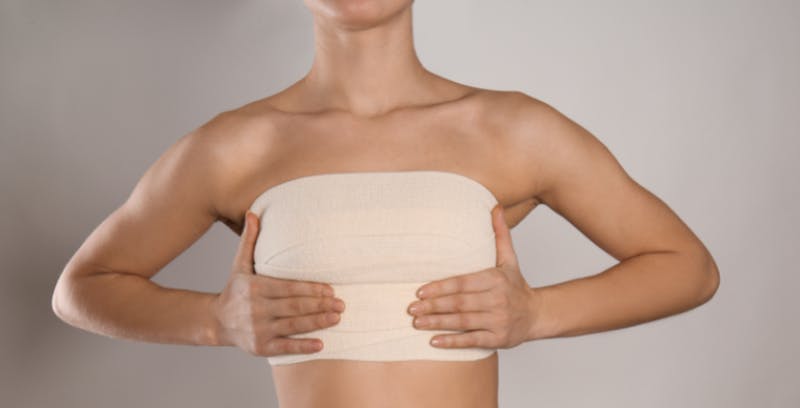
What do you do when you’re unhappy with your breasts’ shape, size, or appearance? Most people just think of implants for improving their breasts. However, there are a variety of breast enhancement cosmetic procedures that do and don’t involve implants. Depending on your concerns and desired outcome, a surgeon will recommend the best breast enhancement procedure for you. Breast lifts and breast augmentations make up the two most common breast cosmetic procedures. So what’s the difference between a breast lift vs. breast augmentation?
Both breast augmentation and breast lift procedures can improve the appearance of the bust area, but are designed to address different concerns and achieve specific desired results. Some women want to enhance their breasts due to changes after pregnancy, breastfeeding, or weight loss, and some women desire to enhance or change their natural breast size, shape, or overall appearance.
This article will discuss the difference between a breast lift vs. breast augmentation and the overall results each procedure is designed to give in order to help you decide which one is right for you.
Breast Lifts
Aging, pregnancy, breastfeeding, and weight loss can all lead to loss of volume in the breasts. Loss of breast volume can lead to breast ptosis, causing sagging and drooping. A breast lift procedure helps correct droopiness or sagging by volumetrically reshaping the breasts. Breast lifts can be performed on breasts of all sizes. However, results may not last as long for larger breasts, and your surgeon may suggest a breast reduction as well for best results.
There are three different approaches to breast lift procedures; periareolar, vertical breast reduction, and inverted-T incisions. These three different incision options allow the surgeon to correct any level of ptosis and produce a customized, ideal sculpted look.
A periareolar incision follows the natural areolar shape and is best for someone who has larger areolas and breast drooping that needs minimal correction. A vertical breast reduction incision follows the same path as the periareolar around the areola while also extending down, which allows for a greater lift for moderate breast drooping. An inverted-T incision follows the same path as the periareolar and vertical breast incision while including an incision in the breast fold, allowing for maximum breast lift. The right approach will depend on the amount of breast volume, tissue, and degree of ptosis you have.
Advantages of a Breast Lift
- Improved shape, perkiness, projection, and breast symmetry
- Improved confidence and better fitting clothing
- Minimally visible scars, with most scarring hidden beneath the breasts
- Long-lasting results
- Doesn’t require implants
Breast Lift Process
Before your breast lift procedure, you’ll have a consultation with your surgeon to assess your current concerns, clear you as a good candidate for surgery, and decide on which approach is best for your needs and desired outcome. Afterward, you’ll be given a pre-surgery plan to follow up until the day of surgery.
After your breast lift procedure, you’ll be required to rest for ten days, and then you can resume low-impact daily activities. After six weeks, you’ll be cleared to go back to most of your usual activities and movement. However, you still may need to reduce any heavy lifting for an additional month. Your surgeon will give you proper aftercare instructions before sending you home and during your follow-up appointments.
Breast Augmentations
Breast augmentation procedures utilize implants to improve the size, shape, and appearance of the breasts. Breast augmentations are ideal for patients who want to address concerns, including asymmetrical breasts or breast tissue, small breasts, or poor breast projection.
There are three things to consider when choosing the right breast augmentation approach: incision and implant placement, implant shape and size, and type of implant. There are three standard incisions for breast augmentations which include:
- Inframammary – under the fold of the breast
- Trans-axilary – in the armpit
- Periareolar – around the nipple
Each different incision technique has its own advantages, and your surgeon will determine which incision is the best approach for you during your consultation.
There are so many different options to choose from when it comes to the right implant shape and size for you. Your surgeon will take into consideration your chest wall shape, body shape, lifestyle, and desired look to make the best implant suggestion for you.
For the type of implant, your surgeon will either have a preference they like to work with or offer you the option of silicone or saline and suggest which one they’d recommend for you. Multiple factors play into which type of implant is best for you, such as your desired results, personal preference, and body type. Silicone implants are usually more expensive and require a larger incision. However, silicone implants have a more natural, realistic feel and are ideal for patients with little natural breast tissue. Saline implants are best for patients who already have a decent amount of natural breast tissue and want to add more volume and shape.
Advantages of a Breast Augmentation
- High-satisfaction rate
- Customizable look
- Long-lasting results
- Balance out the body shape
- Better fitting clothes
- Improved body image and self-confidence
- Inconspicuous scarring
Breast Augmentation Process
You’ll have a consultation with your surgeon before your breast augmentation procedure to address your concerns, make sure you’re healthy enough for surgery, and determine the best approach to achieve your desired results. Afterward, you’ll be given a pre-surgery plan to follow up until the day of surgery.
After your breast augmentation procedure, you’ll be recovering for four to six weeks and not allowed to perform any strenuous movement or heavy lifting during that time. Your surgeon will give you post-op recovery instructions after your procedure before sending you home and tell you what activities you’re cleared for during your follow-up appointments.
Combining Breast Lift and Breast Augmentation
For some patients, a breast lift and breast augmentation may be the best route to achieve the patient’s desired outcome. Often the two are combined to address all the patient’s concerns. Sometimes, a breast lift surgery can slightly reduce the size of the breasts. This isn’t an issue for all patients, but for patients who already have a smaller breast size or want to keep their same size, it may be good to include a breast augmentation. Adding implants to a breast lift may also be suitable for patients who want to fix an inflated look and add more volume.
Patients may want to add on a breast lift to their breast augmentation procedure to provide a more lifted, perkier, youthful look to the breast if sagging is also a concern. Having a breast augmentation with a breast lift will give you some upper breast fullness along with repositioning sagging breasts and nipple areas.
Breast Lift vs. Breast Augmentation: The Bottom Line
In the end, deciding to get a breast lift vs. breast augmentation, or both is up to you and your preferences. The first step to choosing which option is best for you is scheduling a consultation with a surgeon who will go over your concerns, desired outcome, and options in order to make the best suggestion.
Ready to get started? Leif Rogers, MD, is an Ivy League-educated, board-certified plastic surgeon and a standing member of the American Society of Plastic Surgeons. If you’re considering a breast lift or breast augmentation, get in touch with his team to schedule a consultation.

